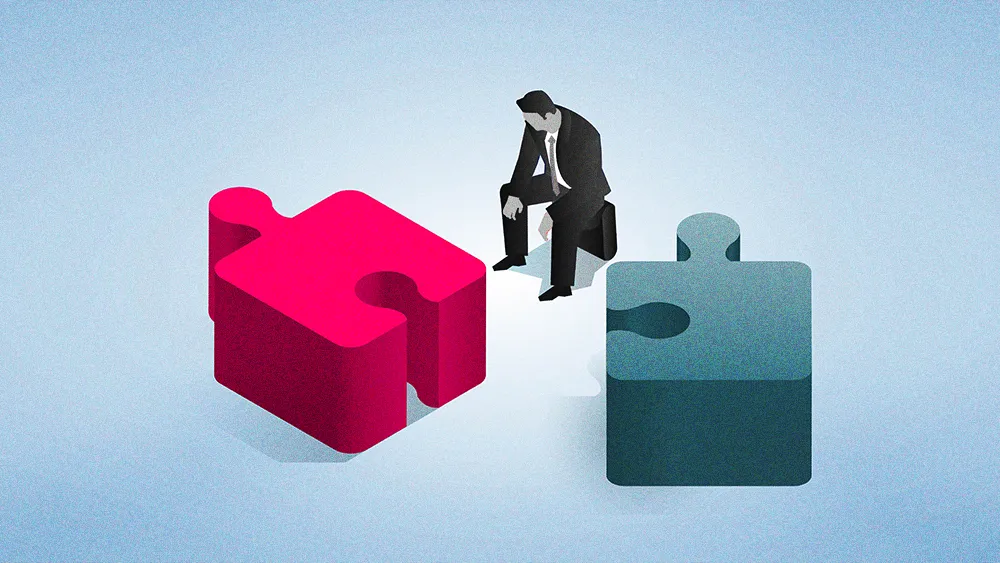Distributing work among a human-AI workforce requires ‘capability orchestration’

Key Points
Agentic AI is tearing down traditional HR structures, forcing leaders to redesign the very definition of work.
Cole Napper, VP of Research, Innovation, and Talent Insights at Lightcast, argues that leaders must first deconstruct work into generic tasks for AI and differentiated tasks where humans provide a competitive edge.
Napper warned that layering AI onto human teams creates compounding complexity that static, rigid job architectures cannot manage.
Once you get an AI agent to a level of reliability, the complexity associated with the basic management of tasks is going to compound overnight. Multiply that by thousands of people and thousands of agents over millions of tasks, and all of a sudden this becomes unmanageable very quickly.

Cole Napper
VP of Research, Innovation, and Talent Insights
Lightcast
The static skills taxonomies and rigid job architectures that have defined corporate structure for decades are crumbling under the pressure of today’s dynamic AI reality. Not only must leaders adopt ever-changing tech without a hitch, but they must redesign the very definition of work itself in the process. That requires a new mindset where leaders must become the orchestrators of a complex system of human skills, AI-driven tasks, and organizational capabilities.
We spoke with Cole Napper, the VP of Research, Innovation, and Talent Insights at Lightcast, the global leader in labor market analytics. The author of People Analytics and host of the Directionally Correct podcast, Napper argued that before any organization can successfully integrate AI, its leaders must first confront a foundational, and almost philosophical, question about the nature of their business: ‘What is work?’
“It seems strange to ask what work is, but you have to break down and understand your work at its core pieces in order to layer on AI and apply that at scale,” said Napper. “That’s a really, really difficult part of the equation.” The capability orchestration framework moves beyond simply cataloging employee skills, dividing the work itself into two distinct categories and identifying the tasks where AI is most useful.
Generic vs. differentiated tasks: “You can break tasks down into ‘generic’ or ‘differentiated,'” Napper explained. “Generic tasks would be like bank telling. It’s essentially the same job in any bank. But every bank has a varied set of customer expectations, and managing those expectations would be the differentiated tasks.” AI agents, he argued, are well-equipped to handle the generic, but it’s the differentiated tasks where human value shines. That is a company’s competitive edge.
AI compounds complexity: When you begin layering AI agents onto human teams, the complexity compounds at an alarming rate. “Once you get an AI agent to a level of reliability, the complexity associated with the basic management of tasks is going to compound overnight,” Napper warned. “Multiply that by thousands of people and thousands of agents over millions of tasks, and all of a sudden this becomes unmanageable very quickly.”
The complexity is precisely why old, static systems fail. “Pre-AI, you’d spend so much time setting up the job architecture, then some change in the organization happened, and that dynamism broke the job architecture on day one,” Napper recalled. “It was a terrible feeling.” That dynamism is even more apparent with the rapid advancement of AI. Over the past three years alone, the average job has seen 32% of its skills change.
This reveals a central, sobering irony at the heart of the AI revolution. The area where organizations need the most help is precisely the area where AI is least effective. The differentiated tasks that are unique to each company and change the fastest are the very ones that are hardest for AI to handle.
To address that irony, leaders need to directly address AI’s increasing presence in the workplace and the tension it creates for employees. Some companies made headlines for a “stick” approach, like laying off workers only to scramble to rehire people with AI skills months later. Napper, on the other hand, advocated for the “carrot.” That carrot, he argued, is compensation.
Compensation driver: “We found that if you just add one AI skill to a job description, the pay goes up by 28%,” Napper revealed. “And if you add two or more skills, it’s 42%.” The fields with the largest premium for AI skills are customer and client support, sales, and manufacturing and production, but the pay bump is happening across industries.
Human skills still dominate: Even in roles explicitly looking for AI skills, human-based skills and the ability to perform differentiated tasks like communication, leadership, and analytical thinking are still the most sought-after skillset. “This all goes back to differentiated vs. generic skills,” Napper said. “You need AI and humans to get the job done.”
Managing this new, complex ecosystem of humans and agents will require a new class of software that doesn’t exist yet. “To do this at scale amongst all the different skills, tasks, jobs, people, and agents, is going to require a level of coordination that has never existed in software,” Napper predicted. “Whoever unlocks this is probably going to be a multibillion-dollar organization fairly quickly.”
Pre-AI, you'd spend so much time setting up the job architecture, then some change in the organization happened, and that dynamism broke the job architecture on day one. It was a terrible feeling.

Cole Napper
VP of Research, Innovation, and Talent Insights
Lightcast
Pre-AI, you'd spend so much time setting up the job architecture, then some change in the organization happened, and that dynamism broke the job architecture on day one. It was a terrible feeling.

Cole Napper
VP of Research, Innovation, and Talent Insights
Lightcast
Related articles
TL;DR
Agentic AI is tearing down traditional HR structures, forcing leaders to redesign the very definition of work.
Cole Napper, VP of Research, Innovation, and Talent Insights at Lightcast, argues that leaders must first deconstruct work into generic tasks for AI and differentiated tasks where humans provide a competitive edge.
Napper warned that layering AI onto human teams creates compounding complexity that static, rigid job architectures cannot manage.

Cole Napper
Lightcast
VP of Research, Innovation, and Talent Insights

VP of Research, Innovation, and Talent Insights
The static skills taxonomies and rigid job architectures that have defined corporate structure for decades are crumbling under the pressure of today’s dynamic AI reality. Not only must leaders adopt ever-changing tech without a hitch, but they must redesign the very definition of work itself in the process. That requires a new mindset where leaders must become the orchestrators of a complex system of human skills, AI-driven tasks, and organizational capabilities.
We spoke with Cole Napper, the VP of Research, Innovation, and Talent Insights at Lightcast, the global leader in labor market analytics. The author of People Analytics and host of the Directionally Correct podcast, Napper argued that before any organization can successfully integrate AI, its leaders must first confront a foundational, and almost philosophical, question about the nature of their business: ‘What is work?’
“It seems strange to ask what work is, but you have to break down and understand your work at its core pieces in order to layer on AI and apply that at scale,” said Napper. “That’s a really, really difficult part of the equation.” The capability orchestration framework moves beyond simply cataloging employee skills, dividing the work itself into two distinct categories and identifying the tasks where AI is most useful.
Generic vs. differentiated tasks: “You can break tasks down into ‘generic’ or ‘differentiated,'” Napper explained. “Generic tasks would be like bank telling. It’s essentially the same job in any bank. But every bank has a varied set of customer expectations, and managing those expectations would be the differentiated tasks.” AI agents, he argued, are well-equipped to handle the generic, but it’s the differentiated tasks where human value shines. That is a company’s competitive edge.
AI compounds complexity: When you begin layering AI agents onto human teams, the complexity compounds at an alarming rate. “Once you get an AI agent to a level of reliability, the complexity associated with the basic management of tasks is going to compound overnight,” Napper warned. “Multiply that by thousands of people and thousands of agents over millions of tasks, and all of a sudden this becomes unmanageable very quickly.”
The complexity is precisely why old, static systems fail. “Pre-AI, you’d spend so much time setting up the job architecture, then some change in the organization happened, and that dynamism broke the job architecture on day one,” Napper recalled. “It was a terrible feeling.” That dynamism is even more apparent with the rapid advancement of AI. Over the past three years alone, the average job has seen 32% of its skills change.

Cole Napper
Lightcast
VP of Research, Innovation, and Talent Insights

VP of Research, Innovation, and Talent Insights
This reveals a central, sobering irony at the heart of the AI revolution. The area where organizations need the most help is precisely the area where AI is least effective. The differentiated tasks that are unique to each company and change the fastest are the very ones that are hardest for AI to handle.
To address that irony, leaders need to directly address AI’s increasing presence in the workplace and the tension it creates for employees. Some companies made headlines for a “stick” approach, like laying off workers only to scramble to rehire people with AI skills months later. Napper, on the other hand, advocated for the “carrot.” That carrot, he argued, is compensation.
Compensation driver: “We found that if you just add one AI skill to a job description, the pay goes up by 28%,” Napper revealed. “And if you add two or more skills, it’s 42%.” The fields with the largest premium for AI skills are customer and client support, sales, and manufacturing and production, but the pay bump is happening across industries.
Human skills still dominate: Even in roles explicitly looking for AI skills, human-based skills and the ability to perform differentiated tasks like communication, leadership, and analytical thinking are still the most sought-after skillset. “This all goes back to differentiated vs. generic skills,” Napper said. “You need AI and humans to get the job done.”
Managing this new, complex ecosystem of humans and agents will require a new class of software that doesn’t exist yet. “To do this at scale amongst all the different skills, tasks, jobs, people, and agents, is going to require a level of coordination that has never existed in software,” Napper predicted. “Whoever unlocks this is probably going to be a multibillion-dollar organization fairly quickly.”




